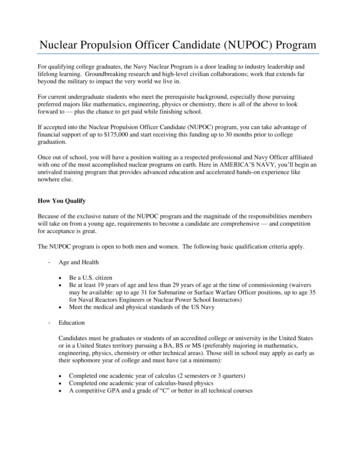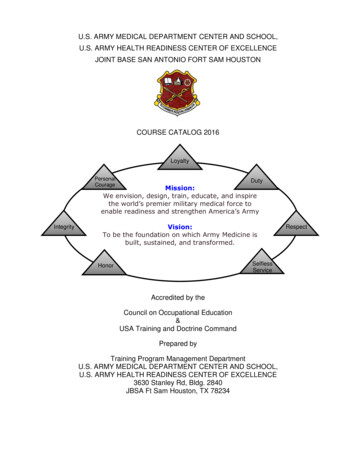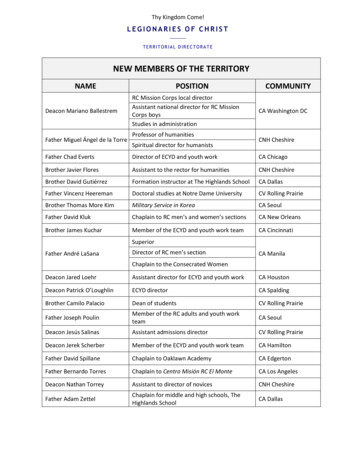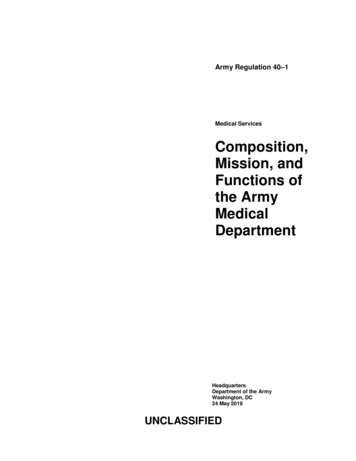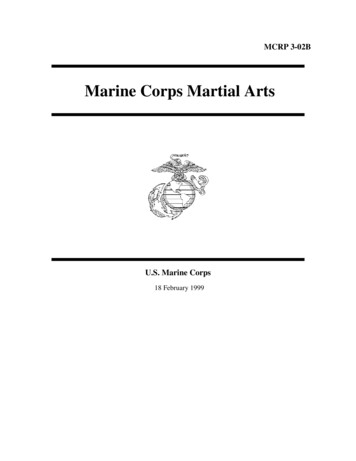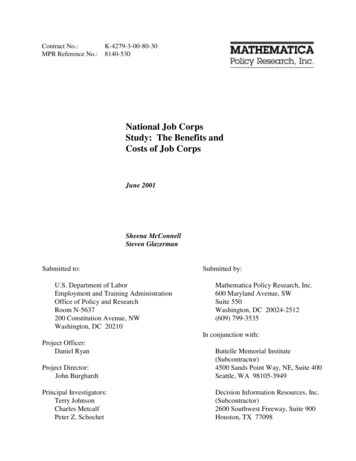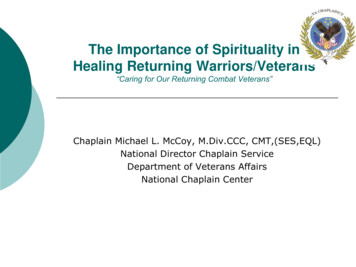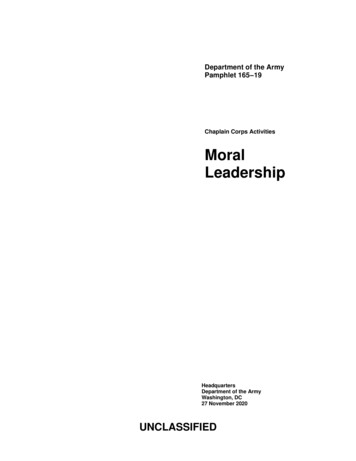
Transcription
Department of the ArmyPamphlet 165–19Chaplain Corps ActivitiesMoralLeadershipHeadquartersDepartment of the ArmyWashington, DC27 November 2020UNCLASSIFIED
SUMMARY of CHANGEDA PAM 165–19Moral LeadershipThis administrative revision, dated 11 December 2020—oCorrects Foundations of Army Ethic (fig 2–1).oThis new Department of the Army pamphlet, dated 27 November 2020—oSupports all Army professionals in understanding Army concepts of moral leadership for personal, institutional,and operational education, training, and development with conceptual foundation from current Army leaderdevelopment policy, doctrine, and practice, as well as historical moral and ethical foundations (throughout).oSupports Army professionals in understanding that in accordance with existing policy and doctrine on leadershipand the Army Profession, that moral leadership is not separate from concepts of Army leadership, and should beunderstood as being fully nested with and subordinate to Army leadership doctrine (Army Doctrine Publication6–22) (throughout).oSupports Army professionals tasked with moral leadership training in understanding the concept of moralleadership in regards to self-development and implementation of moral leadership training within the institutionaland operational domains (throughout).oClarifies general concepts of moral leadership, moral development, moral reasoning, and ethical decision makingapplicable to the total force with discussion on the Army ethic, the Army Values, the spiritual dimension, and theimpact of religious freedom and diversity (throughout).oClarifies the moral leadership role of the Army Chaplain Corps executed in the defined capabilities andresponsibilities for moral advisement, moral leadership, and training including issues of pastoral care,confidentiality, internal advisement, and moral injury (throughout).
HeadquartersDepartment of the ArmyWashington, DC27 November 2020Department of the ArmyPamphlet 165–19Chaplain Corps ActivitiesMoral LeadershipHistory. This publication is an administrative revision. The portions affected bythis administrative revision are listed inthe summary of change.Summary. This pamphlet provides information and instructional guidance regarding concepts of moral leadership inthe Army that undergird moral leadership that includes a full analysis of the extraining.pected benefits and must include formalreview by the activity’s senior legal ofApplicability. This regulation appliesficer. All waiver requests will be endorsedto the Regular Army, the Army Nationalby the commander or senior leader of theGuard/Army National Guard of therequesting activity and forwarded throughUnited States, and the U.S. Army Retheir higher headquarters to the policyserve, unless otherwise stated. It also approponent. Refer to AR 25–30 for specificplies to the Department of the Army Ciguidance.vilians.Suggested improvements. UsersProponent and exception authority.are invited to send comments and sugThe proponent of this publication is thegested improvements on DA Form 2028Chief of Chaplains. The proponent has the(Recommended Changes to Publicationsauthority to approve exceptions or waivand Blank Forms) directly to the Chief ofers to this regulation that are consistentChaplains, 2700 Army Pentagon Washwith controlling law and regulations. Theington DC 20310–2700.proponent may delegate this approval authority, in writing, to a division chief Distribution. This pamphlet is availawithin the proponent agency or its direct ble in electronic media only and intendedreporting unit or field operating agency, in for command levels for the Regularthe grade of colonel or the civilian equiv- Army, the Army National Guard/Armyalent. Activities may request a waiver to National Guard of the United States, andthis regulation by providing justification the U.S. Army Reserve.Contents (Listed by paragraph and page number)Chapter 1Introduction, page 1Purpose 1–1, page 1References and forms 1–2, page 1Explanation of abbreviations and terms 1–3, page 1Moral leadership, character, and readiness 1–4, page 1Chapter 2Moral Leadership Concepts, page 2Morals and ethics 2–1, page 2The Army Ethic 2–2, page 2Religion and the spiritual dimension 2–3, page 3Integrating the Army Ethic and personal belief 2–4, page 4Army leadership and moral leadership 2–5, page 4Moral leadership respects diversity and religious freedom 2–6, page 5Chapter 3Chaplain Corps Roles and Moral Leadership, page 5Chief of Chaplains roles related to moral leadership 3–1, page 5Chaplain Corps capabilities and functions 3–2, page 5Pastoral care, confidentiality, and moral leadership 3–3, page 6Internal advisement and moral leadership 3–4, page 6DA PAM 165–19 27 November 2020UNCLASSIFIEDi
Contents—ContinuedMoral injury, the Chaplain Corps, and moral leadership 3–5, page 7Chapter 4Moral Leadership Training and Education, page 8General 4–1, page 8Moral leadership training and ethics in the institutional training domain 4–2, page 9Moral leadership training and the operational training domain 4–3, page 10Assessment supporting effective operational Moral Leadership Training 4–4, page 11Determining moral leadership training topics following unit/organizational assessments 4–5, page 12Unit Moral Leadership Training planning considerations 4–6, page 13Moral Leadership Training and the self-development training domain 4–7, page 13Moral Leadership Training resources 4–8, page 14AppendixesA. References, page 15B. The Army Ethic, page 17C. An Ethical Reasoning Framework within Design Methodology, page 19D. The Joint Ethics Regulation Ethical Decision-Making Framework, page 22E. An Ethical Reasoning Model within the Military Decision-Making Process, page 24Figure ListFigure 2–1: Foundations of the Army Ethic, page 3Figure 4–1: The Army Leader Development Model, page 9Figure 4–2: The analysis, design, development, implementation, and evaluation process for learning product development, page 10Figure B–1: Army Ethic, page 18Figure C–1: An ethical reasoning framework for examining options, page 20GlossaryDA PAM 165–19 27 November 2020ii
Chapter 1Introduction1–1. PurposeThis publication supports all Army professionals in understanding concepts of moral leadership in support of currentArmy leader development policy, doctrine, and practice. The Army has long held that the moral aspects of leadershipare critical for Army professionals and leaders. Chapter 2 describes the general concepts of moral leadership as itapplies to the total force. Chapter 3 describes the moral leadership role of the Chaplain Corps (CHC) in defined capabilities and responsibilities for moral advisement and training. While moral leadership is a concern of every Armyleader, the CHC has since its founding been charged with responsibility to help ensure the Army aspires to highestmoral standards. On 29 July 1775, almost a year before the Declaration of Independence, the Continental Congressacted on General Washington’s request to authorize one chap-lain for every Continental Army regiment. This actionprioritized the importance of building an Army that was morally and spiritually strong. Providing moral and ethicalleadership continues to be a critical aspect of the CHC mission (see FM 1 – 05 and AR 165 – 1). The Army continuesto charge the CHC with responsibility to support MLT by placing HQDA proponency and responsibility for moralleadership with the CCH as leader of the Chaplain Corps (see AR 350 – 1). Chapter 4 concludes with concepts ofMoral Leadership Training (MLT) in self-development, institutional, and operational domains to support the planningand execution of relevant and effective MLT and development programs.1–2. References and formsSee appendix A.1–3. Explanation of abbreviations and termsSee glossary.1–4. Moral leadership, character, and readinessa. The Army acknowledges moral leadership as a critical support to character development and is expected to beof increasing importance in support of total force readiness. The U.S. Army Operating Concept describes significantreadiness challenges the Army will face when anticipating armed conflict marked by increased complexity, threats,enemies, and adversaries that are becoming increasingly capable and elusive. These challenges highlight the need todevelop morally sound leaders and cohesive teams that will thrive in conditions of complexity and uncertainty. Therefore, Army concepts and the Army's Force 2025 and Beyond comprehensive strategy identify leader development asa near-term priority, noting that competent ethical leadership cannot be substituted with advanced technology or sophisticated weaponry.b. Character is central to leadership throughout Army doctrine as required to develop mutual trust and cohesiveteams within mission command, which in turn strengthens resilience and personal and unit readiness. Character development is a unifying theme within The Talent Management Concept of Operations for Force 2025 and Beyond; isan essential requirement for Leader Development (Army Leader Development Strategy, ADP 6 –22); and is integralto the Army meeting five of the Army Warfighting Challenges (4, 8, 9, 10, and 19). ADP 6–22 clarifies the centralityof morals and values in leadership. Intrinsically or individually, character is one’s true nature including identity, senseof purpose, values, virtues, morals, and conscience. Operationally, character is an Army professional’s dedication andadherence to the Army ethic, including Army Values, as consistently and faithfully demonstrated in decisions andactions.c. Moral leadership is critical to three logically distinct, but related, aspects of total force readiness by enhancingand developing a sustained, motivated, and ethical force:(1) Sustainment readiness. By preparing and influencing Army professionals to be mentally strong and resilientduring periods of hardship, crisis, or stress to enhance moral injury prevention.(2) Motivational readiness. By helping Soldiers and leaders integrate deeply held personal core beliefs and valueswith moral foundations in order to motivate individual efforts to accomplish Army missions.(3) Ethical readiness. By influencing Army professionals and organizations to accomplish missions as an ethicalforce. Ethical failures even at the lowest tactical levels can have devastating strategic impact on mission and theArmy’s standing with Americans and the international community.DA PAM 165–19 27 November 20201
Chapter 2Moral Leadership Concepts2–1. Morals and ethicsa. Morals refer to a sense of right and wrong in principles, values, and conduct. Federal law recognizes the moralresponsibility of every Army leader stating: “All commanders and others in authority in the Army are required to bevigilant in inspecting the conduct of all persons who are placed under their command, guard against and suppress alldissolute and immoral practices, and to correct, according to the laws and regulations of the Army, all persons whoare guilty of them.” (See Title 10, United States Code, 7233 (10 USC 7233)).b. The office Army professionals enter upon taking their oath is not a physical workspace; it is a moral workplace.Every Department of the Army (DA) Civilian, enlisted Soldier, and officer takes an oath morally committing themselves to support and defend the Constitution of the United States and fulfill their duties in faithful obedience to lawfulauthority. An oath is a public moral commitment that binds Army professionals to accepting risk of serious personalharm or even death. Moral failures can devastate the Army’s standing with Americans and the international community. In combat operations, Soldiers must balance between the need to obey superiors without hesitation and legal andmoral use of violence in service of the Nation (see ADP 6 –22).c. While the terms moral and ethical are often used interchangeably, the two overlapping terms may be distinguished. Moral may be understood to refer to general right and wrong in the broadest sense. Ethical systems, codes,norms, and expectations for conduct should seek to be moral. This is true of the Army ethic described as having “itsorigins in the philosophical heritage, theological and cultural traditions, and the historical legacy that frame our Nation” (see ADP 6–22).d. Ethics refers to a system of moral principles, or rules of conduct recognized in respect to a class of humanactions, a particular group or culture. Ethics reflects upon how morality is practically applied to decisions made incontexts and communities, such as the Army, that possess shared guidelines, norms, expectations, and commitments.Some ethics are universally applicable throughout the Army, such as the Army ethic, the Army Values or the JointEthics Regulation’s detailed guidance regarding gifts, political activity, nonfederal entity relationships, and conflictsof interest. Some ethics are particular to more local or specific standards of moral or professional behavior.e. Authoritative laws, directives, and policy establish moral and ethical boundaries for conduct by Army professionals, especially regarding use of lethal land power. Where laws of armed conflict and rules of engagement fail toprovide clear courses of action, decisions should conform to moral aspects of the Army ethic. Ethical issues are simpleto assess when law or the Army ethic are clear. For example, ongoing willful violations of the law of war or rules ofengagement are clearly unethical, but ethical reasoning is often complex and difficult in practice, requiring deep analysis and critical thinking. For such complex cases, multiple ethical perspectives may help leaders think through ethicalconcerns. Brief descriptions of some of these ethical perspectives include the following:(1) The virtue perspective, which looks toward desirable character traits of the individual to understand what isethical in the form of desirable virtues such as courage, justice, and benevolence, and how best to instill such virtues.(2) The deontological perspective, which understands ethical outcomes derived from a set of agreed-upon valuesand rules rather than the consequences of the action.(3) The utilitarian perspective, which seeks decisions producing the greatest good and best outcome for the greatestnumber as most favorable.f. Concepts from Army Design Methodology can help frame the right problem and consider ethical implications indetail (see ATP 5 –0.1). Appendix C contains a sample ethical decision-making framework employing Army DesignMethodology with basic ethical perspectives. Appendix D provides an alternate ethical decision-making frameworksuggested by the Joint Ethics Regulation.2–2. The Army Ethica. The Army ethic is the set of enduring moral principles, values, beliefs, and laws that guide the Army professionand create the culture of trust essential to Army professionals in the conduct of missions, performance of duty, and allaspects of life. It has origins in the philosophical heritage, theological and cultural traditions, and the historical legacythat frame our Nations ethical core. The Army ethic, which is described at length in ADP 6–22, is summarily expressedin appendix B.b. The foundations of the Army ethic depicted in figure 2–1 motivate and guide appropriate conduct in the Army.Legal and regulatory standards found in codified documents such as the U.S. Constitution, the Uniform Code of Military Justice, and the U.S. Code of Federal Regulations are part of the Army ethic, as are other legal requirements suchas lawful orders, the law of armed conflict, and rules of engagement. Deliberate failure to meet these minimum legalnorms for ethical conduct may result in legal punishment or other consequences. In addition to legal foundations, theDA PAM 165–19 27 November 20202
Army also draws the moral foundations of its ethic from traditions, customs, and documents with moral content andcivic importance. The Army ethic establishes moral and ethical boundaries for conduct by all Army professionals.Figure 2 – 1. Foundations of the Army Ethicc. The Army Values. The Army Values are part of, and inherent to, moral principles of the Army ethic, and specifically include:(1) Loyalty. Bear true faith and allegiance to the U.S. Constitution, the Army, your unit, and other Soldiers. Thismeans supporting the military and civilian chain of command, as well as devoting oneself to the welfare of others.(2) Duty. Fulfill obligations. Duty is the legal and moral obligation to do what should be done without being told.(3) Respect. Treat people as they should be treated. This is the same as the Golden rule: “do to others as you wouldhave done to you.”(4) Selfless service. Put the welfare of the Nation, the Army, and your subordinates before your own. This meansputting the welfare of the Nation and accomplishment of the mission ahead of personal desires.(5) Honor. Live up to the Army Values. This implies always following your moral compass in any circumstance.(6) Integrity. Do what is right, legally, and morally. This is the thread woven through the fabric of the Army ethic.It means honesty, uprightness, the avoidance of deception, and steadfast adherence to standards of behavior.(7) Personal courage. Face fear, danger, or adversity (physical or moral). This means being brave under all circumstances.2–3. Religion and the spiritual dimensiona. The spiritual dimension as defined in the Army is based on an individual's core religious, philosophical, psychological, or personal values, and forms an individual's sense of identity, purpose, motivation, character, and integrity.These elements, which define the essence of a person enable one to build inner strength, make meaning of experiences,behave ethically, persevere through challenges, and be resilient when faced with adversity (see AR 350 –53 and AR600–63).DA PAM 165–19 27 November 20203
b. Individual beliefs rooted in personal religion and spirituality are often critical considerations of moral leadership.An Army professional’s moral and ethical viewpoint and their motivation to follow what they understand to be rightare shaped and driven by these personal core values and beliefs defined as the spiritual dimension.c. Religion may be described as a set of beliefs concerning a divine or transcendent cause, nature, and purpose ofthe universe typically accompanied with devotional and ritual observances along with an accompanying moral codegoverning the conduct of human affairs. Most Army professionals identify with some form of religious belief underlying the spiritual dimension, and religion is therefore often (but not always) the critical factor in individual moraloutlook and motivation. Moral leadership involves a leaders’ ability to understand and respect religious and spiritualbeliefs in order to influence moral behavior in Army organizations.d. Strong support for the exercise and practice of religion is reflected in DoD and Army policy concerning theaccommodation of religion. This requires leaders to ensure that Soldiers and Department of the Army Civilians haveopportunity to practice their faith, at times requiring exception to generally applicable rules in order to avoid a substantial burden to a person’s sincere religious belief (see DoDI 1300.17 and AR 600–20). Army leaders should fosterrespect for the diverse religious, spiritual, and philosophical traditions that constitute spiritual beliefs that make America and its Army strong. This respect is applied to all, to those holding to sincere religious belief, or no religious beliefat all. Consistent practice of one’s own religion, character and integrity reinforces the moral norms of the Army ethic.2–4. Integrating the Army Ethic and personal beliefa. Personal moral beliefs grounded in the spiritual dimension inform and motivate Army leaders' actions, decisions,and leadership philosophies. Such personal viewpoints must be consistent and integrated with adherence to, and pursuit of, the Army Ethic, Army Values, and mission objectives. Personal morality inevitably extends beyond ArmyValues, including diverse cultural, religious, and philosophical beliefs and traditions.b. The Army Ethic and Army Values are the common foundation upon which all Army professionals should basetheir ethical conduct. Personal convictions may provide further motivation and philosophy to build upon this foundation. The guidelines of the Army ethic do not provide specific courses of action for all moral and ethical issues orsituations Army professionals face. However, in official actions and decisions, personal convictions and values mustalign with the Army ethic and Values to which Army leaders and professionals have committed themselves by oath.Army leader development, education, and all domains of training should seek to spur reflection and articulate clarityon how an individual best integrates and applies their own personal beliefs with the Army ethic.2–5. Army leadership and moral leadershipa. Leadership. Leadership is the activity of influencing people by providing purpose, direction, and motivation toaccomplish the mission and improve the organization (see ADP 6 –22). This definition applies to all Army professionals both military and civilian.b. Moral leadership. Army leadership is expected to be inherently moral. Moral leadership is the process of influencing people by providing moral purpose, direction, or motivation to accomplish the mission and improve the organization consistent with the Army ethic.c. Character. Throughout Army leadership policy and doctrine, character is listed first among the three leaderattributes (see AR 600–100 and ADP 6–22). The other attributes are presence and intellect. Character is described asthe moral and ethical quality that help leaders determine what is right and gives a leader motivation to do what isappropriate regardless of the circumstances or consequences. It is in the process of becoming a person of strong character that one develops as a good leader (see AR 600 –100).d. Moral courage. Army leadership doctrine emphasizes moral courage as a critical aspect of moral leadership.Moral courage is the commitment to do what is right despite risk, adversity, and fear. It empowers leaders to standfirm on values, principles, and convictions in taking responsibility for decisions and actions. Army leaders must beprepared to balance moral interests in protecting Soldiers' safety and lives while ensuring mission accomplishment.(1) Moral courage to make hard decisions, risking Soldiers’ lives and using lethal force against opposing forces ismorally justifiable to protect the Nation and is often a requirement where the best decision entails cost to personalsafety, reputation, or career advancement.(2) Moral courage enables ethical and moral decisions when facing pressure from superiors preferring opposingshort-term objectives; it may also require resistance to subordinates' preference for reduced exposure to hardship orrisk of injury.(3) Moral leadership seeks to instill moral courage throughout Army organizations to foster climates that encouragespeaking out against sexual harassment, hazing, rules of engagement violations, and other immoral conduct.DA PAM 165–19 27 November 20204
2–6. Moral leadership respects diversity and religious freedoma. Army leaders are expected to demonstrate the moral and ethical compass for their organizations but must do sowithout using their official position to coerce particular religious convictions upon others.b. The First Amendment of the U.S. Constitution states, “Congress shall make no law respecting an establishmentof religion or prohibiting the free exercise thereof .” Pluralistic concerns represented by the First Amendment areconcerns reinforced in other mandates of law and policy. Civil rights and equal opportunity law and policy undergirdan Army commitment to provide equal opportunity and fair treatment for military personnel and families withoutregard to race, color, sex, religion, sexual orientation, or national origin. DoD 5500.07 –R, Joint Ethics Regulation(JER) requires all Army leaders and Soldiers to “adhere strictly to (this) policy of equal opportunity.” Furthermore,under the JER, leaders avoid official actions and statements appearing to endorse religious groups or organizations.c. Army professionals have a right to religious expression in the workplace, but must avoid statements or actionsthat could suggest or imply official government endorsement, or preferential treatment, of non-Federal entities suchas religious organizations or faith groups in accordance with the JER, paragraph 3 –209. Personal moral and religiousconvictions that make up the spiritual dimension may, and should, inform and motivate Army leaders' official leadership philosophies, decisions and actions. Such personal viewpoints should be consistent with faithful adherence andpursuit of these pluralistic principles grounded in the First Amendment and Army Ethic and Values.Chapter 3Chaplain Corps Roles and Moral Leadership3–1. Chief of Chaplains roles related to moral leadershipa. The CCH is charged with exercising HQDA responsibility for moral leadership for the entire Army (see AR350–1). Related to this broad Armywide responsibility, the CCH is specifically charged as leader of the CHC to:(1) Advise the Secretary of the Army and the Chief of Staff of the Army on chaplaincy matters (to include therequired capability to advise commands at all echelons on morals and ethics discussed in para 3–2).(2) In coordination with the Assistant Secretary of the Army (Manpower and Reserve Affairs) (ASA (M&RA),develop and provide training at Army schools on topics to include ethics, moral leadership, spiritual fitness and Soldierand Family readiness.(3) Establish and maintain strategic-level leader development venues, working groups, and councils.(4) Advise and coordinate with the Armed Forces Chaplains Board and the Joint Staff Chaplain on matters ofmorals and ethics.(5) Provide advice and assistance to Army leaders on the religious and spiritual connections associated with themoral responsibilities of command, ethical decision- making, personal values, and personal relationships.b. The CCH fulfills these Armywide responsibilities by providing leadership and technical supervision to all Chaplain Corps personnel who execute MLT on behalf of the CCH. As leader of the Chaplain Corps in this regard andmoral leadership matters, the CCH is responsible for the following:(1) Assist the ASA (M&RA) by developing and implementing Chaplain Corps policy, plans and programs.(2) Direct Chaplain Corps support and assistance in resilience programs.(3) In coordination with the ASA (M&RA), direct the professional training and development of all Chaplain Corpspersonnel to include provision of specialized training to chaplains in Ethics, Biomedical Ethics, and Chaplain ClinicalEthics.(4) In coordination with the ASA (M&RA), develop and publish the chaplaincy training strategy, annual ChaplainCorps training guidance, and training products executed at the garrison, State, and/or territory, region, or commandlevel.(5) Lead and support commanders’ chaplain-led MLT programs supporting the Army Profession and Ethic that:(a) Address the religious, moral, social, and ethical dimensions of Soldier and civilian actions in war and peacetime operations.(b) Build cohesive units with morally sound and strong Soldiers, DA Civilians, and Families by addressing moral,ethical, social, and spiritual issues.3–2. Chaplain Corps capabilities and functionsa. General. Alongside CHC responsibilities described in the preceding paragraph, there are functions assigned tothe Chaplain Corps at every echelon of command. These functions, or required capabilities, are authoritatively captured under broad headings that may be summarized as a) provide religious support and b) advise the command (seeAR 165–1 and FM 1–05). These CHC capabilities are critical supports to moral leadership.DA PAM 165–19 27 November 20205
b. Provide religious support. For sustainment and readiness purposes, the Army requires the CHC capability toperform or provide RS in supporting free exercise of religion and resiliency. This capability includes, but is not limitedto, religious functions in the traditional sense of the word religion such as worship services, rites and sacraments, andreligious education. Additionally, this capability includes general spiritual and pastoral care for all. Religious support,explained in Army doctrine as a CHC role, is applicable and relevant for all personnel including functions such asgeneral pastoral counseling and care regarding moral and family life issues. Paragraph 3–3 describes the personal andconfidential pastoral care functions that support moral leadership in ways only the CHC is responsible and capable ofproviding for all those affiliated with a religion, as well as those who are not. For most Army professionals who doindeed identify with a particular religion, faith-specific RS functions (for example, worship services, rites, sacraments,ordinances, and religious education) are fundamental to moral leadership, since the spiritual dimension of these religious adherents grounds their sense of identity, purpose, motivation, character, and integrity, enabling one to buildinner strength (and) behave ethically.c. Advise the command on religion, morals, and ethics. The chaplain advises commands at all echelons on religion,morals, ethics, and morale (see AR 165 –1, FM 1 –05, and ATP 1–05.04). This advice capability breaks down furtherinto external (see ATP 1 –05.03) and internal (see ATP 1–05.04) advisement. External advisement is concerned withthe mission impacts of the religious environment of a population within an area of operations; it is the internal advisement CHC capability that is of particular importance, impacting moral leadership and is described in paragraph 3–4.3–3. Pa
This publication supports all Army professionals in understanding concepts of moral leadership in support of current Army leader development policy, doctrine, and practice. The Army has long held that the moral aspects of leadership are critical for Army professionals and leaders. Chapter 2 describes the general concepts of moral leadership as it
